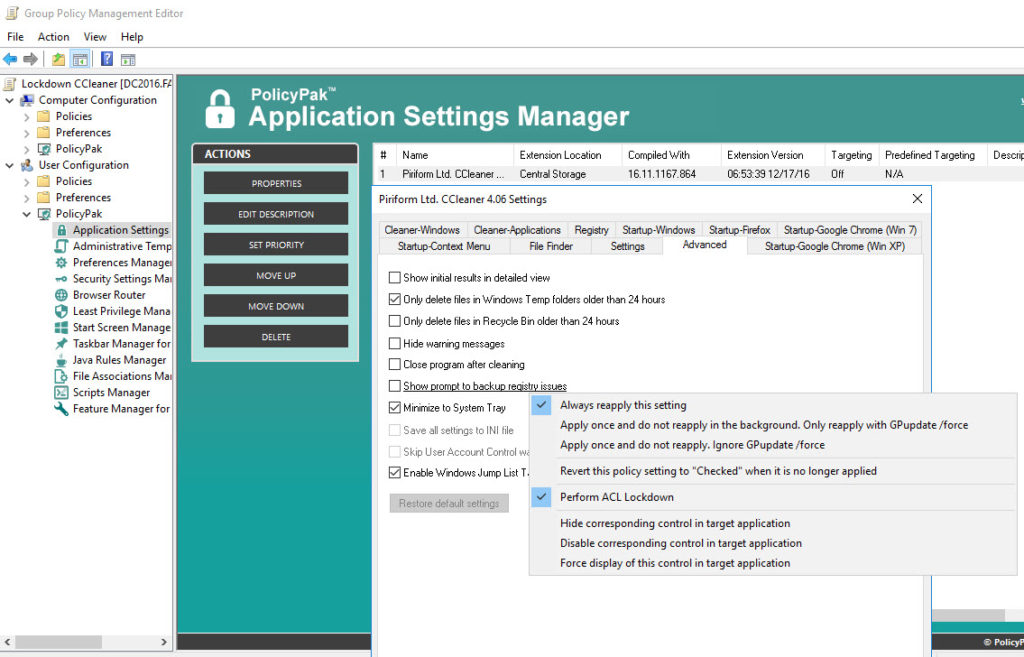It’s so easy for your users to clean junk and temporary files from their computer with just a few simple mouse clicks using CCleaner.
The problem is that they can zap out the wrong things as well in an instant, which will generate a call to the helpdesk, and maybe even a visit.
Suddenly this beneficial program is causing a lot of havoc.
That’s where PolicyPak comes in. We enforce and lock down the optimum settings values that you, the administrator, want them to have. PolicyPak sets and enforces expectations for your users’ applications, so that they get the same experience, every time they launch it.
Ensure your CCleaner settings are dictated and ensured using PolicyPak. Get those settings out there using Group Policy, SCCM or your own management tool.
Check out this video to see how it’s done using Group Policy:
Our PolicyPak software snaps-in to the Group Policy Editor and gives you a GUI interface which mimics the interface of CCleaner itself. You always want CCleaner to empty your Recycle Bin and delete your Temporary Files so make sure these selections are always checked using PolicyPak.
You don’t want your users managing the application updates for CCleaner or just about any application for that matter. PolicyPak allows you, the administrator, to manage updates for this and so many other applications. Simply uncheck “Automatically check updates to CCleaner” and lock this setting all the way down to the registry itself by using PolicyPak’s signature feature, ACL Lockdown. Simply right click on this or just about any setting and select “Perform ACL Lockdown” and even the savviest registry user cannot alter your delivered settings.
Make sure your users are prompted about registry items by always delivering a checked value for “Show prompt to backup registry issues.” Then use ACL Lockdown for this setting as well.
With PolicyPak, you’re the one in control.
Besides, once you’re using PolicyPak to manage CCleaner, you’ll also get to manage all your other enterprise desktop applications the same way: Flash, WinZip, Firefox, and any custom applications you have. They’re 100% included – absolutely free.
It’s all included when you’re a PolicyPak Professional customer.
PolicyPak was designed by Microsoft MVP, Enterprise Mobility Jeremy Moskowitz – who “wrote the book” on Group Policy, runs GPanswers.com, and lives and breathes Group Policy and enterprise software deployments and desktop lockdown.
When you’re ready to get serious about managing CCleaner, PolicyPak is ready for you.
Lockdown CCleaner Video Transcript
Hi, this is Jeremy Moskowitz, Microsoft MVP, Enterprise Mobility and Founder of PolicyPak Software. In this video, we’re going to learn how to configure CCleaner using PolicyPak.
I’ve already got CCleaner installed on my computer, and I’m just a regular user here. As you can see, I’m logged on as a guy called “eastsalesuser4.” I’ll open up CCleaner, go to Options – Settings, and examine the configuration settings a user has access to.
Here in Settings you have some critical settings that govern how CCleaner will run. If you click on the CCleaner icon you see the types of files and file locations CCleaner targets. Clicking Registry shows you some important application settings and when it comes to the registry, let’s face it, every setting is important.
CCleaner is registry based application which means a computer savvy user can access the registry and get around your desired settings. I have the registry location saved here where your user could go straight into it and modify the setting for “UpdateCheck” and change the value from 1 to 0. As you can see, EastSalesUser4 has the rights to do this. No Admin rights required.
Now let’s see how we can ensure compliance and perform desktop management of settings quickly using PolicyPak. I’ll go ahead and switch over to my Management Station computer.
We’ll go ahead and right click over our “East Sales Users”, “Create a GPO” and we’re going to call it “Lockdown CCleaner.” So this GPO is now associated with the “East Sales Users.” I’ll right click over it. I’ll click “Edit…” I’ll dive down under “User Configuration / PolicyPak/Applications/New/Application.” There it is, “PolicyPak for Pirform Ltd. CCleaner” along with other applications like “Java,” “Flash” “Firefox,” “Skype” and lots of other important desktop applications that your users utilize every day (and you want to make more secure).
Let’s start with “CCleaner” and let’s configure what file types you would want CCleaner to delete. Let’s make sure “History” and “Cookies” are always unchecked and that “Saved Passwords” and “Empty Recycle Bin” are always checked. Notice that each setting became underlined as soon as its value is changed. This means that the setting value will be delivered with PolicyPak.
Now let’s go to “Settings” where you can make sure that “Run CCleaner when the computer starts” is always checked so it’s always available for your users and let’s uncheck “Automatically check for updates to CCleaner” is unchecked so that your users don’t manage updates for this application. Now, let’s lock these settings all the down to the registry itself by using PolicyPak’s unique feature, ACL Lockdown. This will prevent computer savvy users from modifying my delivered settings within the registry itself. To do so, I’ll just right click either of these settings and select “Perform ACL Lockdown.”
Now I will go back to my client machine, we’ll get a command prompt and run “gpupdate.” Now you could envision the user logging on for the very first time, using a Terminal Services or Citrix machine, using a VDI session, changing job roles, or getting a new computer. I just happen to be using gpupdate. Yes, PolicyPak performs the magic. To get the magic delivered, you can use Group Policy, SCCM, LanDesk, KACE or your own systems management software. Even if the user is offline, your settings are always preserved because PolicyPak is always working for you in the background, making the job of you the administrator, easier.
Now let’s open up CCleaner again and check your settings. Notice that “History” and “Cookies” are indeed unchecked and that “Saved Passwords” and “Empty Recycle Bin” are checked. Now we’ll go to “Settings” and we see that “Run CCleaner when the computer starts” is checked and that “Automatically check for updates to CCleaner” is unchecked as you wanted.
Now let’s pretend this user tries to change the settings in within the registry itself. I’ll open up the file once again and to attempt to modify “UpdateCheck” and as you can see the efforts of this user has been thwarted. PolicyPak with ACL Lockdown has locked down these file based settings.
And we are done. That is how incredibly easy it is for you to use PolicyPak to manage CCleaner as well as tons of other desktop applications.
If you’re looking for a trial of PolicyPak, just click on the “Webinar / Download” button on the right.
Thanks so much for watching, and get in touch with us if you’re looking to get started. Talk to you soon.




